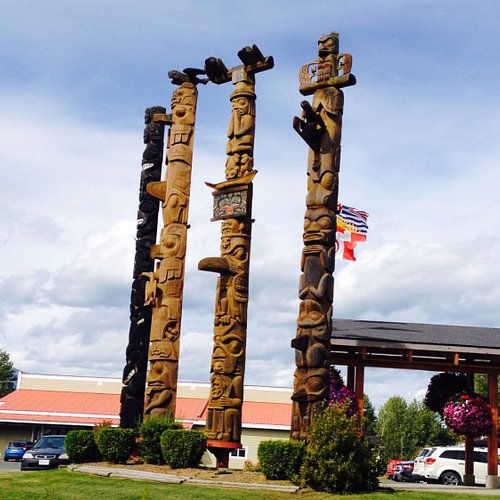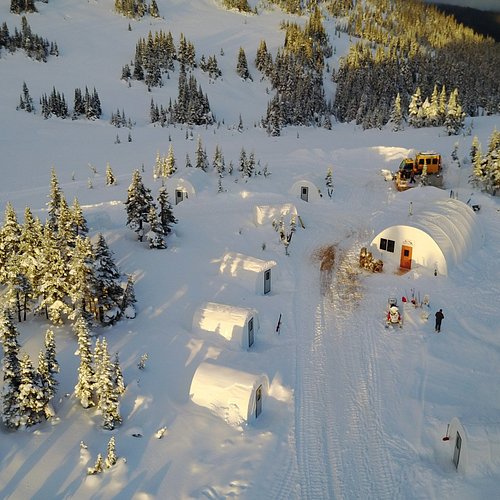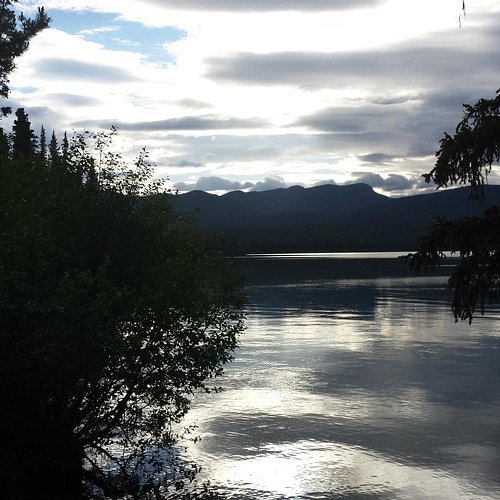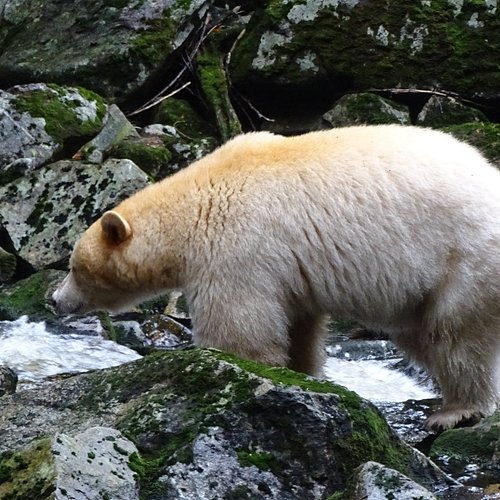Things to do in Kitimat-Stikine District, Kitimat-Stikine District: The Best Nature & Parks
Discover the best top things to do in Kitimat-Stikine District, British Columbia including Nisga'a Memorial Lava Bed Park, Skeena Cat Skiing Inc., Kinaskan Lake Provincial Park, Ross Lake Provincial Park, Kitsumkalum Provincial Park, Babine River Corridor Provincial Park, Green Inlet Marine Provincial Park, Kalum River, Seeley Lake Provincial Park, Kitimat River Provincial Park.
Restaurants in Kitimat-Stikine District
1. Nisga'a Memorial Lava Bed Park
Overall Ratings
5.0 based on 40 reviews
Reviewed By PookyCake - Victoria, Canada
The Nisga’a Memorial Lava Bed Provincial Park is a unique experience. Established in 1992, this Park is the first in British Columbia to be jointly managed between First Nations and BC Parks. As such, it offers visitors an inimitable opportunity to experience rich Nisga’a culture intertwined with natural history. It is, in other words, a place where the Nisga’a culture and Canadian geologic history meet. Indeed, the history of the Nisga’a Memorial Lava Bed is fascinating. When the Tseax Cone erupted circa 1700, it sent millions of pounds of basalt lava flow and rock into the Nass River and valley below, forever altering the physical landscape. Trees were burned (creating “tree casts”); the Nass River was dammed (creating beautiful Lava Lake); and two Nisga’a villages – Lax K’abit and Lax Ksiluux – were destroyed, resulting in the deaths of approximately 2,000 people. When all was said and done, the lava flow extended over a 22 kilometer area and was 3 kilometers wide. Now, over 250 years later, the landscape looks otherworldly, even being described as “moonlike” by some. While the sheer size of the park is somewhat intimidating (clocking it at just over 178 square kilometers), the Nisga’a have performed yeoman’s duty to make sure it’s a manageable experience for visitors via the Nisga’a “Auto tour,” which is available online or at the Terrace and Nisga’a Visitor Centres. The tour is essentially self-guided; however, it sets out key geological and cultural points of interest throughout the park, allowing you to pick and choose what you’d like to see according to your own schedule. The tour sets out 18 different stops; highlights include: Lava Lake, which formed as a direct result of the volcanic eruption and subsequent lava flow, is a picturesque area offering good fishing and swimming opportunities. There are also pit toilets and picnic tables on-site. Crater Creek: This area of the park speaks to the sheer power and force of the eruption. As you amble along this rocky landscape, you can’t help but wonder how it got its name seeing as there’s no creek in the immediate vicinity. Reading the available information, however, you learn that the creek is apparently up to 30 meters below your feet, running below the solidified lava rock. This area also gives a good sense and idea of the type of lava you’ll be encountering throughout much of the park. The first type is “A’A,” which is and jagged; the second type of lava is “Blocky” which, as the name implies, are large chunks that were cast out by the erupting cone. Drowned Forest: This place was the highlight for me. When the waters are high, the Txeas river flows into and over the surrounding forestscape; hence, the name “Drowned Forest.” The green-ish waters, concomitant with the turbulent and roaring falls made for a sublime experience. Absolutely stunning! I’d make the drive back just to see this again. Vetter Falls: Only a short drive from the Drowned Forest, the Vetter Falls represent a contrast of landscapes. Arriving at the pullout, you first walk a short graveled path – surrounded by lava flow on either side – towards the green foliage of forest. From there, you witness the Vetter Falls. While these aren’t the largest Falls in the area, they are one of the easiest to access and photography. The cool waters are inviting for a swim while the general atmosphere lends itself to a sense and feeling of calm. Hot Springs: These are natural hot springs that hold significant cultural importance for the Nisga’a. The natural sulphur smell is said to be that of the “spirit” and thus they ask that you respect the site. The nerdy types will also enjoy the geological process involved in this site, too. Visitors Centre: This is a small building, but an absolutely crucial stop for those who want a well-rounded understanding of the Nisga’a and the Memorial Lava Bed. While here you can receive practical information about the park and its physical features; learn about the Nisga’a legends and oral histories that inform their understanding of the park; and, of course, grab a few souvenirs to take home with you. Indeed, the Nisga’a Memorial Lava Bed Provincial Park offers a number of geological, cultural and outdoor recreational activities for everybody. Even though I did spend a day at the Park, there was still much left unseen. Visiting the Tseax Cone was probably the biggest “miss;” however, one MUST set up a guided tour to visit the cone – no visitors allowed otherwise. Maybe next time. And there will be a “next time.” The Park is just too rich, vast and complex to limit to a single visit.
2. Skeena Cat Skiing Inc.
Overall Ratings
5.0 based on 6 reviews
Skeena Cat Skiing is northern B.C.'s only cat ski destination. Skeena's pristine location, unique camp set up and exceptional service delivers not only fantastic cat skiing but an entire wilderness experience. The developed terrain offers incredible tree skiing, natural glades, open bowls and the steep...something for everyone! Skeena has enjoyed 9 years of operation and continues to open more terrain each season. You just might get a first descent at Skeena! Skeena's Base Camp utilizes quonset style tents to house their guests. The double occupancy bedroom tents are insulated, have a floor, are heated and have electricity. The tents are furnished with real mattresses, wool comforters, comfy pillows and Skeena supplies towels as well as organic shampoo and conditioner. The "common" tent contains the kitchen, dining area and lounge. Moist Pacific air colliding with the cold, dry air from the interior creates the huge dumps of perfect powder snow that Skeena is famous for!!
Reviewed By TravelerGuy802
My wife and I skied here for 4 days. For background, we've cat skied at one other location in BC too, and ski about 25 days/year, mostly in Vermont. We had a great time here! People need to understand that you generally pretty ski tame slopes in terms of pitch when cat skiing. The steeper terrain is too avalanche prone (this is true of most cat ski operations) so you ski slopes with a 30 degree or so pitch. An advanced intermediate can handle the skiing although my wife and I are both experts. Unless you nail your timing perfectly with spring temperatures and snow stability, you won't be skiing 50 degree lines like you see in ski movies. If steep skiing is your thing, you're better off waiting until late spring or going to a formal ski area where they can control avalanche risks daily. We flew into Terrrace airport, which has many more daily flights than recommended Smithers. Depending on exact dates, the staff may be able to pick you up in Terrace but you need to confirm with them prior to booking. After landing at Terrace airport, we had a two hour drive to New Hazelton, followed by a 40 minute car ride, followed by a 30 minute cat ride to base camp. They have a nice main tent with heat, couches, wifi and great food served by a very competent chef. Food was superb. You eat dinner and breakfast in the main tent, and eat lunch (sandwiches, homemade cookies, fruit) on the cat. Each sleeping tent has two twin beds, and heaters. There is a separate bathroom facility and washing facility, with hot water for showers. This means that you need to walk out from your sleeping tent to the bathroom tent to use the bathroom, even at night just to go pee. We generally skied about 15-20 short (less than 1000 feet vertical) runs per day on a mix of alpine and gladed terrain. We had a full cat with several unrelated groups, but everyone had at least an advanced intermediate ability so we never had to wait. The location has more than one snowcat, so the backup cat (normally used for road building) can be used as primary cat if primary breaks down. While this wasn't an issue during our trip, it's extremely valuable to know that your skiing won't be limited because the sole snowcat is broken down and awaiting a spare part that needs to be sent from a parts supplier in a big city. This can happen at other cat ski operations. For us, the group dynamics were odd, but that may be particular to our group. The lead guide had only been guiding this particular location for a few weeks, and lacked the experience of skiing the complete terrain over multiple seasons, which encompasses several thousand acres here. We had several runs which were difficult wind slab that were tough skiing. You don't learn all the terrain nooks and crannies in a few weeks. The tail guide Carla was superb. She was warm, personable, competent, eager to help guests and has skied the terrain over her several years guiding at Skeena. She's a great asset to the organization. We had two minor avalanches during our stay- the first one was caused by a repeat guest who skied beyond the guide's designated boundary (the guides will give you landmarks for how far left and right of their tracks you should go). This person knowingly went slightly outside the guide's direction and caused a small avalanche on themselves. The second avalanche was on a relatively tame (maybe 35 degree) but unskied slope when several people congregated in the same place. The weight of several people in the same spot on the slope crown caused a minor avalanche below them. Nobody was injured in either slide, but several people were very spooked by witnessing the avalanches, and this unease threw the group dynamics off even further than they were before. The group dynamics on our trip were very strained. Guides were justifiably furious with the person who knowingly skied outside of boundary, and there was a lot of arguing. There seemed to be personality clashes too between the tail and lead guide.It's a small group (12 skiers+ 2 guides) so these fights flow through to the entire group. In summary, we had a great experience of skiing powder for 4 days in a very remote area that few people will ever get to see. I will treasure this unique experience for the rest of my life. Seeing the stars at night, the clouds whip over remote peaks, the adventure of the unknown, sharing the passion for skiing and life, good food, and lots of laughs made for a great vacation. If you're the type of person who treasures a unique wilderness active ski vacation, there's nowhere better that I've found. Unlike heli skiing, you won't get grounded due to weather. A special shoutout to Lynn, who helped with the logistics and billing. Without her, we couldn't have made it happen!
3. Kinaskan Lake Provincial Park
4. Ross Lake Provincial Park
5. Kitsumkalum Provincial Park
Overall Ratings
5.0 based on 6 reviews
Reviewed By Grizeagle - Terrace, Canada
Kitsumkalum Provincial Park is situated in a gorgeous, scenic and quiet forested area at the southend of Kalum Lake. The views from here are spectacular with snow-capped mountains , evergreen forests and colorful waters of Kalum Lake. The camping is free here and user maintained with room for 6 or 7 units comfortably. The beach is long and sandy with cold, glacial waters that are refreshing for a dip. Great place for kids to play and explore the beach and mossy parklike forest. Across the Kalum River is Redsand Lake Recreational Site and Hart Farm Recreational Site with free camping also. Redsand Lake has an impressive kilometre long , curved sandy beach. The views of the mountains here are scenic and superb for photos. Several campsites are right along the lakeshore with others up in the pine forest out of the wind. There are trails here that lead you to the Hart Farm Recreational Site and other places around the flat forests on the banks of the Kalum River across from Kitsumkalum Provincial Park. The access to Redsand Lake is via 26 kms. on the West Kalum Forest Road from the Tempo Gas Bar at Kitsumkalum village near Terrace. Recently the road was very rough with many potholes and there was a washout at Redsand Lake Recreational Site entrance. Redsand Lake is a great place to take kids and camp at the rustic campsites that are right on the lake. The scenery is breath-taking and gorgeous at Redsand Lake where the salmon fishing is good in season.
6. Babine River Corridor Provincial Park
7. Green Inlet Marine Provincial Park
8. Kalum River
Overall Ratings
4.5 based on 13 reviews
Reviewed By OnAnotherJourney - Canada, null
This is a difficult location to review partly because there are several points of access (some less known than others) but if you’re willing to get out there you’ll be rewarded with an amazing experience, whether you’re hiking, kayaking or fly fishing. Although I don’t fish, I’ve been told by several people this is one of the best places to fish for steelhead in the world. Not surprisingly there are several local guides who can get you where you want to go.










